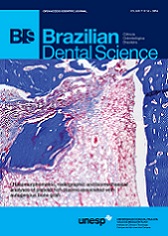Evaluation of the Location of Mandibular Foramen as an Anatomic Landmark Using CBCT Images: A Pioneering Study in an Iranian Population
DOI:
https://doi.org/10.14295/bds.2014.v17i4.1006Resumo
Objective: Mandibular foramen (MF) is located on the internal surface of the ramus through which blood vessels and nerves pass. Determination of the anatomic position of the MF is very important in inferior alveolar nerve block anesthesia (IANBA), ramus osteotomy and surgical procedures of the posterior angle of mandibular ramus. The aim of this study was to determine anatomic position of the MF using anatomic landmarks on the three dimensional CBCT images. Material and Methods: A total of 103 CBCT images was evaluated. The NNT Viewer software program was used to measure the distances between the lines tangent on the MF periphery and the anterior border of the ramus, the posterior border of the ramus, the inferior border of the mandible, and the coronoid notch in mm by to age and gender. Results: The results showed a slight difference in anatomic dimensions between the right and left sides, with no significant differences. The anatomic dimensions of the MF on both sides were a little bigger in males than in females. There were no significant differences in the anatomic dimensions of superior-inferior and anterior-posterior dimensions of the left and right sides in different age groups. Conclusion: No significant changes occur in the position of the MF with age. The anatomic differences between males and females should be taken into account during IANBA procedures. Males have bigger jaws than females; therefore, there is a longer distance between the MF and the anatomic landmarks evaluated.
Keywords: Mandibular Foramen; Anatomic Landmarks; Cone-Beam Computed Tomography
Downloads
Downloads
Arquivos adicionais
Publicado
Como Citar
Edição
Seção
Licença
TRANSFERÊNCIA DE DIREITOS AUTORAIS E DECLARAÇÃO DE RESPONSABILIDADE
Toda a propriedade de direitos autorais do artigo "____________________________________________________________________" é transferido do autor(es) para a CIÊNCIA ODONTOLÓGICA BRASILEIRA, no caso do trabalho ser publicado. O artigo não foi publicado em outro lugar e não foi submetido simultaneamente para publicação em outra revista.
Vimos por meio deste, atestar que trabalho é original e não apresenta dados manipulados, fraude ou plágio. Fizemos contribuição científica significativa para o estudo e estamos cientes dos dados apresentados e de acordo com a versão final do artigo. Assumimos total responsabilidade pelos aspectos éticos do estudo.
Este texto deve ser impresso e assinado por todos os autores. A versão digitalizada deverá ser apresentada como arquivo suplementar durante o processo de submissão.
























